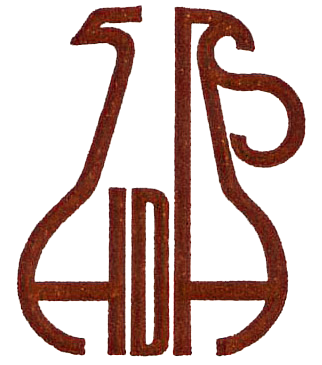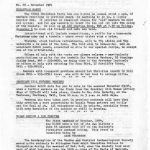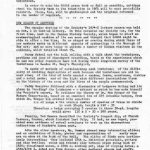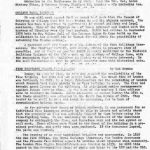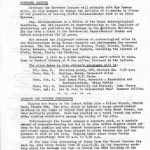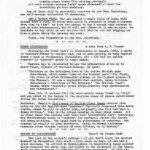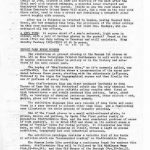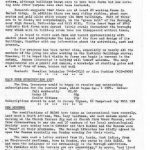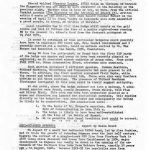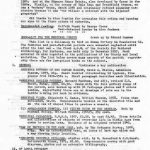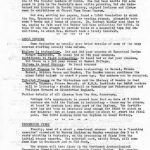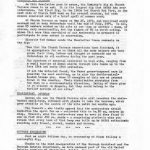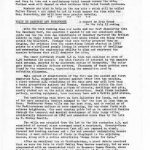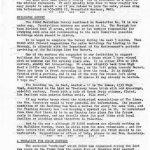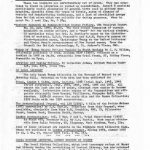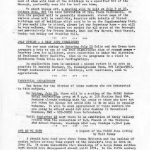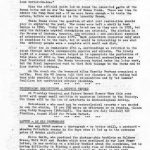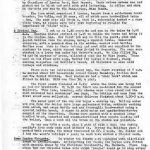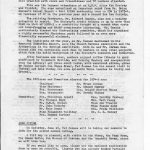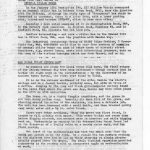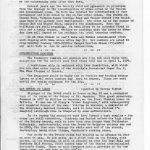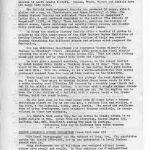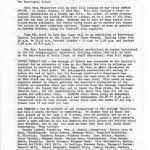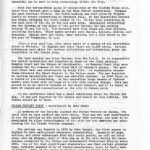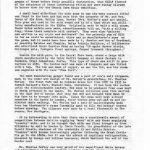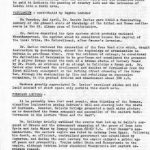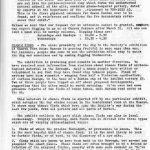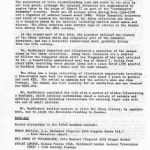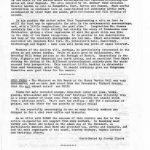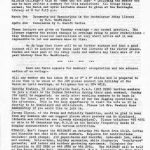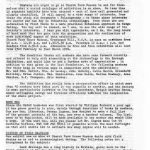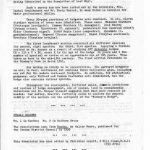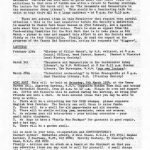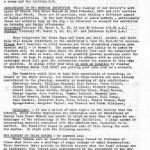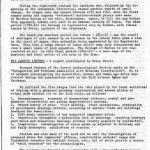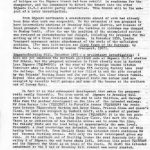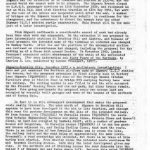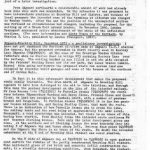Newsletter
Page 1
Christmas Party
The HADAS Christmas party has now become an annual event — and, if members reactions in previous years are anything to go by, a highly popular one. It provides an excellent chance for “old” members to meet and natter; and for new members to break the ice and get into the swing of the Society. So roll up at 166 Station Road, NW4, at 7.30p.m. on Friday 6 December to meet old friends and make new ones.
Entertainment will include competitions, a raffle for a home-made Christmas cake and a tombola — where every ticket wins a prize.
Tickets, which include refreshments, will be £0.75 adults and £0.50 Under-14s — on sale at the door. The food will be home-made; and an excellent HADAS punch, concocted on site to our special recipe, is always one of the attractions.
Offers of help with the party are always welcome — particularly contributions or gifts for the Tombola (to Dorothy Newbury) or bring them to the November lecture); or offers to help with catering (to Joan Bird).
Members with transport problems should let Christine Arnott know; she will do her best to arrange lifts. she would do her best to arrange lifts.
Brockley Hill Pottery Weekend
Another HADAS date for you to note is the weekend November 23/24, when a further work-in on the finds from the Brockley Hill Roman Pottery digs of 1939-56 will take place, thanks to Mr John Enderby, at the Teahouse, Northway, NW11, from 10.00 a.m.-5.00 p.m. on both days.
Members who have taken part in previous weekends will know that this provides a rare opportunity to handle Roman Pottery and really get the feel of it. All volunteers will be welcome, especially those with some knowledge of the subject or skill in drawing.
HADAS writes a new chapter
The first weekend in October 1974, saw HADAS make a bit of its own history — when 43 members took off on the Society’s first-ever weekend outing. This event is described below by Anne Thompson.
The headquarters of the Hendon and District Archaeological Society moved quite suddenly to Attingham Park Adult Education College in Shropshire during the weekend of October 4-6, when the Society took over part of what had once been the eighteenth century home of the Earls of Berwick. This fine Mansion, built by George Steuart in 1785, with its restful country park setting and elegant interiors (including “second-hand” drawing room furniture which belonged to Napoleon’s Sister Pauline Borghese) was an ideal base for expeditions into the surrounding countryside.
The programme was planned to suit all interests. Many of us specially enjoyed Wroxeter, first a Roman legionary fortress and then developed as the tribal capital of the Cornovii. There we had the benefit of a very lucid guided tour and later slides and a talk from Mr Toms, Warden of Attingham and also, by a happy chance, Secretary of the Shropshire Archaeological Society. He is also one of the leading diggers, under Dr Graham Webster, of Wroxeter – Roman Viroconium.
Page 2
The site is outstanding in two ways. It has been unoccupied since Saxon times, and it is the only site of a Roman City bought by the Department of the Environment to ensure uninterrupted excavation. In themselves the baths, gymnasium and market square already excavated are impressive, especially in conjunction with the wealth of finds which can be seen at Rowley’s House Museum in Shrewsbury (literally piles of Samian bowls found exactly as they were stacked in the market shops before sudden destruction by fire c 170 AD).
Perhaps even more interesting is the evidence now coming to light of numerous timber buildings on the ruins of the baths and market, with at least 10 different occupation layers. Future excavations at Wroxeter may help to solve many problems which still exist about the growth of and life in Romano-British towns.
The streets of Shrewsbury and Much Wenlock, with its priory, gave us a glimpse of medieval Shropshire; while the historians cast longing glances at the hill-forts of Wenlock Edge — which, however, must await exploration another time.
Sunday was industrial archaeology day, centering on Ironbridge Gorge. Here we saw the famous Iron Bridge, first of its kind in the world, and visited the very beginnings of the Industrial Revolution. In this steep sided valley Abraham Darby first used coke to smelt iron ore, and thereby changed the face of the industrial world. Coalbrookdale itself retains intact its atmosphere of an iron-making village community, and its Quaker iron-makers are buried in a small cemetery high above on the valley side. We climbed into Darby’s own furnace; and in the nearby Museum saw recorded the development of the district and fine examples of cast iron in its heyday.
A museum of a different kind was the 42-acre woodland site of Blists Hill, where industrial monuments are preserved in natural settings. Here we marvelled at the work put in by enthusiastic local volunteers who act as guides at the Museum and are reconstructing much of the machinery. One big task is re-making the famous Hay Inclined Plane, a railroad system for raising canal boats 207 feet up and down between canal and river without having to use 27 locks.
For the technically minded their were blast furnaces, mining machinery and beam engines, as well as a pottery and the printing shop. Natural bitumen had been accidentally discovered in 1787 in the course of tunnelling. We were able to explore part of the resulting “Tar Tunnel”, a source of bitumen for medicine and industry, and could picture the poor workers “like the imps described by Dante as gathering with a hook the souls of the damned in a sea of pitch” as one contemporary Italian said. The tar is now a trickle – luckily for us.
All thanks for this full and interesting weekend to Jeremy Clynes, whose idea it was, and to Dorothy Newbury, Eric Grant and Colin and Ann Evans, who helped Jeremy organise it. May it be the first of many weekend ventures for HADAS.
Local Press Cuttings
Our indefatigable Librarian, George Ingram, has come up with an idea on which he hopes members may help. The local newspapers — such as the Hampstead and Highgate Express, the Hendon Times, the Finchley Press, and the Barnet Press — often carry interesting material on aspects of local history. Mr Ingram would like to be able to keep, in the HADAS book box, cuttings of such items.
He would also like to maintain a press cuttings book of local press reports of the Society’s activities.
Would any members who normally take one of the above papers be prepared to read them each week from this point of view, and to let Mr Ingram have cuttings of any item which may be of interest? Cuttings could be photocopied and returned if necessary. If you think you could help, please give Mr Ingram a ring and tell him which paper you are prepared to “watch”.
Page 3
The sort of cuttings (in addition to actual mentions of HADAS) which would be useful to include: articles on the history of old buildings or their threatened redevelopment; material on people connected with the district e.g. Bulwer Lytton in Totteridge, Warwick the Kingmaker in Hadley, Richard Cromwell in East Finchley, etc; reproductions of old prints, postcards and photos; information which throws light on the history of street names; or details of the closing of old established businesses.
In order to make his HADAS press book as full as possible, cuttings about the Society back to its foundation in 1961 will be most gratefully received. These, too, will be photocopied and the original returned to the lender if required.
New season of lectures
The opening meeting of the Society’s 1974-5 lecture season was held on 1 October at Central Library. On this occasion our Society was, for the first time, host to the Camden History Society, which hopes to start an archaeological section of its own soon and thought that HADAS might be able to offer a few tips. So we staged an evening during which three of our members spoke on different aspect of archaeology in the Borough of Barnet; and we were happy to welcome a number of Camden visitors in the audience, which totalled about 75.
Percy Reboul set the ball rolling with a talk about the techniques, problems and joys of churchyard recording, based on the experience which he and other recorders have had during their long-term survey of the tombstones in Hendon St. Mary’s Churchyard.
He spoke of methods of card-indexing each tombstone; of the difficulty of avoiding duplication of work because old tombstones are not in neat rows; of the kind of tools needed — spades, forks, secateurs, sickles and a metal probe; and of the light which different inscriptions throw on the history of the area and the lives of the people commemorated.
Paddy Musgrove followed with a discussion of hedgerow dating and its place in “reading” the landscape — a subject on which he has made himself the Society’s expert. He outlined the theory of Dr. Max Hooper of the Nature Conservancy, based on an examination of 227 dateable hedges, from which Dr Hooper has evolved this equation:
Age of hedge = the average number of species of trees and shrubs in each 30 yard length x 110 + 30
Therefore a hedge averaging five species in three 30 yard lengths would give: 110 x 5 + 30 = 580 years.
Finally, Ted Sammes described the Society’s longest dig, at Church Terrace, Hendon, which finished last July. It had, as was hoped, provided some evidence of actual artefacts to back up the documentary indications of Hendon’s Saxon past.
Like the other speakers, Mr Sammes showed many interesting slides; and an exhibition of finds, photos and reproductions of early maps was on show at the back of the hall. The slides of finds were particularly interesting; they included eighteenth century imitation porcelain, pottery and wine bottles; coins and tokens; clay tobacco pipes going back to 1620; tin-glazed wares, a 16th century cooking pot, pins of varying dates, a 15th/16th century lobed cup from Surrey, other medieval sherds and chaff-tempered ware dated AD 700-1050.
One specially interesting find was a bronze double-headed spiral pin of a type which some experts place in the sixth century, while others think it is 8th/9th century. Whichever is right, this pin falls within that Dark Age period whose existence in Hendon HADAS has been particularly anxious to establish.
Page 4
Local History Conference
The London and Middlesex Archaeology Society, to which HADAS is affiliated, runs two special conferences a year. One in March, is on London archaeology; the other, each November, is on local history.
This year’s Local History Conference will be held on Saturday November 16th, at the Livery Hall of Guildhall, EC2. Doors open at 1.30 to allow time to see the exhibits mounted by local societies. Proceedings begin at 2.30.
The main talk will be by Margaret Gelling, on “New Approaches to the Study of Place Names”. It is likely to be of special interest to archaeologists because of recent attempts to correlate place-name study with the increasing body of actual evidence being found by Dark Age archaeologists. One result of this correlation has been to throw serious doubt on the theory that names ending in -ings (e.g. Hastings) or -ingham (e,g. Buckingham) belong to the early years of Saxon infiltration.
Admission to the Conference is by ticket from the Hon. Sec., Local History Committee — £0.40 including tea.
College Farm, Finchley
It was with much regret that we heard last week that the Museum of Dairying at College Farm has been broken up and the objects were removed. The Museum has been a pleasure to generations of schoolchildren and local residents. Many of the objects were of local interest and linked with the history of Finchley over the last century. HADAS had written in September 1973 both to Mr Walter Nell of the Express Dairy Co (who built up the collection in the Museum) and to Barnet Council about the possibility of retaining the Museum locally.
A question mark now hangs over the future of the farm buildings themselves. The Finchley Society, like HADAS, wishes to preserve them if possible; and at their suggestion HADAS recently submitted to the Historic Buildings Division of the GLC a note on the history of College Farm, with the suggestion that the buildings be Listed as of historic interest. In the next Newsletter to we hope to publish extracts from this historical note.
Fire Insurance Plates
By Ted Sammes.
Today, in case of fire, we take for granted the availability of the Fire Brigade; but this has not always been so. The Great Fire of London was followed, in 1667, by a Royal Proclamation for the rebuilding of London which decreed that there should be no more building in wood. The Fire had brought great losses to the citizens; it stimulated active arrangements against future losses by fire. By the turn-of-the-century, 3 fire offices were in business in London. These increased in number during the eighteenth century, but their stability was affected by the South Sea Bubble in 1720. They tended to be small in size and local in operation, due to lack of communication between towns.
As few streets were named or houses numbered, it was necessary for an individual Fire Insurance Society to be able to locate and quickly check that the property on fire was actually insured by them before using its fire-fighting team. It was obviously in the interests of the insurance company to extinguish the fire, and therefore each had its own symbol or wall mark. These plates were fixed to the front of the building in a prominent position, and early ones were numbered. If the insurance lapsed, the plate was removed.
The keeping of so many individual brigades was uneconomic. In 1826 the Sun Fire Office, the Royal Exchange Assurance, the London Assurance and the Phoenix Fire Office agreed to combine their brigades when necessary. The London Fire Engine Establishment was founded in 1833; in 1866 this was passed to the Metropolitan Board of Works and later at to the LCC and the GLC.
Fire marks can be found on old buildings and many are decorative. One of the earliest is the Hand in Hand (1692). During the main period of use (1680-1880) over 150 companies issued plates in copper, zinc, lead, and in sheet iron. They were usually embossed and when painted must have stood out from the walls very clearly.
I am compiling a list of these marks in the Borough of Barnet and have located the following Hendon:
Royal Insurance at 36 Bell Lane, 5-6 Burroughs Gardens, 67 The Burroughs.
Sun Insurance at 2-4 Shirehall Lane.
If you know any others, please record their location and send details, preferably in writing, to Ted Sammes.
